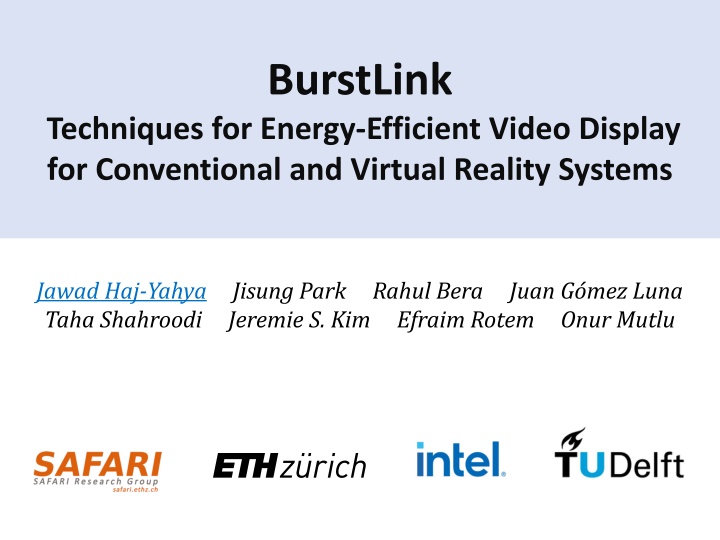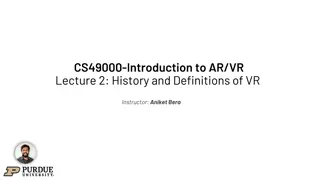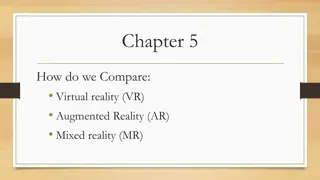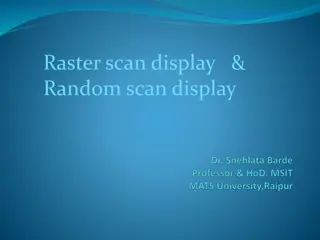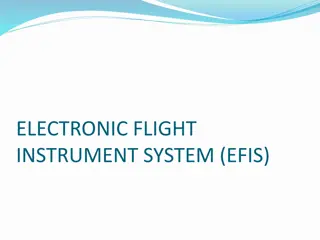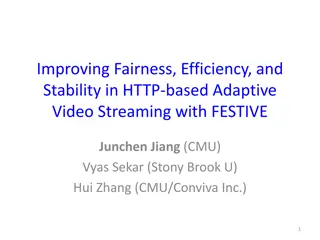BurstLink Techniques for Energy-Efficient Video Display in Reality Systems
This study delves into the application of BurstLink techniques for enhancing energy efficiency in video display within both conventional and virtual reality systems. The work conducted by Jawad Haj-Yahya, Jisung Park, Rahul Bera, Juan Gómez Luna, Taha Shahroodi, and Jérémie S focuses on optimizing display mechanisms to support the seamless operation of video content while reducing energy consumption. Their findings offer insights into improving system performance while conserving energy resources.
Download Presentation

Please find below an Image/Link to download the presentation.
The content on the website is provided AS IS for your information and personal use only. It may not be sold, licensed, or shared on other websites without obtaining consent from the author.If you encounter any issues during the download, it is possible that the publisher has removed the file from their server.
You are allowed to download the files provided on this website for personal or commercial use, subject to the condition that they are used lawfully. All files are the property of their respective owners.
The content on the website is provided AS IS for your information and personal use only. It may not be sold, licensed, or shared on other websites without obtaining consent from the author.
E N D
Presentation Transcript
BurstLink Techniques for Energy-Efficient Video Display for Conventional and Virtual Reality Systems Jawad Haj-Yahya Jisung Park Rahul Bera Juan G mez Luna Taha Shahroodi Jeremie S. Kim Efraim Rotem Onur Mutlu
Executive Summary Problem: planar and virtual reality (VR) video streaming consumes significant system energy due to the high power consumption of major system components (e.g., DRAM, display interfaces, and display panel) Goal: improve the energy efficiency of planar and VR video streaming by leveraging display panel local memory to eliminate buffering frames in main memory Mechanism: BurstLink, a new planar and VR video streaming scheme that - Directly transfers a full decoded video frame from the video-decoder (or GPU) to the display panel, completely bypassing the host DRAM - Transfers a complete decoded frame to the display panel in a burst, exploiting the display interface s maximum bandwidth Evaluation: we evaluate BurstLink using our open-sourced analytical power model that we rigorously validate on an Intel Skylake mobile system. BurstLink: - Reduces system energy consumption for 4K planar/VR video streaming by 41%/33% - Provides an even higher energy reduction in future planar video streaming systems with higher display resolutions and/or display refresh rates 2 https://github.com/CMU-SAFARI/BurstLink
Presentation Outline 1. Overview of Mobile SoC Microarchitecture 2. Motivation and Goal 3. BurstLink I. II. Frame Buffer Bypassing Frame Bursting 4. Evaluation 5. Conclusion 3
Overview of a Traditional Display Subsystem Display Panel Processor Chipset Network Stores the current frame for self-refresh of the LCD when displaying a static image CPU (application) T-con Remote Frame Buffer (RFB) PMU 5 1 2 Video Display 3 Decoder (VD) Controller (DC) Buffer eDP Receiver eDP GPU Interconnect Pixel Formatter (PF) 4 Memory Controller LCD Interface DRAM LCDDisplay Encoded Frames Frame Buffer A conventional display subsystem consists of five main components: In the processor: In the display panel: 1. Video Decoder (VD) 3. embedded-DisplayPort (eDP) Receiver 2. Display Controller (DC) 4. Pixel Formatter (PF) 4 5. Remote Frame Buffer (RFB)
Planar Video Processing Stages Display Panel Processor Chipset Network CPU (application) T-con Remote Frame Buffer (RFB) PMU Video Display Decoder (VD) Controller (DC) Buffer eDP Receiver eDP GPU Interconnect Memory Controller Pixel Formatter (PF) LCD Interface DRAM LCDDisplay Encoded Frames Frame Buffer Planar video processing consists of three main stages: Buffering the encoded frames Decoding the buffered frames Displaying the decoded frames 5
Presentation Outline 1. Overview of Mobile SoC Microarchitecture 2. Motivation and Goal 3. BurstLink I. II. Frame Buffer Bypassing Frame Bursting 4. Evaluation 5. Conclusion 6
Two Problems in Video Processing 1. Unnecessary Data Movement to/from Host Memory 2. Underutilization of Display Interface (eDP) Bandwidth 7
1. Unnecessary Data Movement Processor Display Panel Chipset Network CPU (application) T-con Remote Frame Buffer (RFB) PMU Video Display Decoder (VD) Controller (DC) Buffer eDP Receiver eDP GPU Interconnect Memory Controller Pixel Formatter (PF) LCD Interface DRAM LCDDisplay Encoded Frames Frame Buffer In current video processing schemes, the video decoder stores each decoded frame into the frame buffer in the host DRAM This is necessary only when other planes exist in addition to the video plane (e.g., background, application-graphic plane, and cursor) DC reads the data chunk from each plane s frame buffer, generates one composite chunk out of them, and sends the composite chunk to the display 8
1. Unnecessary Data Movement Processor Display Panel Chipset Network CPU (application) T-con Remote Frame Buffer (RFB) PMU Video Display Decoder (VD) Controller (DC) Buffer eDP Receiver eDP GPU Interconnect Our goal is to prevent unnecessary data movement to/from host DRAM with minimal changes to current mobile SoC microarchitectures Memory Controller Pixel Formatter (PF) LCD Interface DRAM LCDDisplay Encoded Frames Frame Buffer In current video processing schemes, the video decoder stores each decoded frame into the frame buffer in the host DRAM This is necessary only when there exist other planes in addition to the video plane (e.g., background, application-graphic plane, and cursor) DC reads the data chunk from each plane s frame buffer, generates one composite chunk out of them, and sends the composite chunk to the display We prevent unnecessary data movement via Frame Buffer Bypassing (described later) 9
2. Underutilization of eDP Bandwidth Display Panel Processor Chipset Network CPU (application) T-con Remote Frame Buffer (RFB) PMU Video Display Decoder (VD) Controller (DC) Buffer eDP Receiver eDP GPU Interconnect Memory Controller Pixel Formatter (PF) LCD Interface DRAM LCDDisplay Encoded Frames Frame Buffer The DC sends decoded frame data to the display panel in a constant rate during the entire frame window, keeping the DC and the eDP receiver continuously active The transfer rates of the DC, eDP receiver, and pixel-formatter (PF) are tightly coupled and bottlenecked by the PF The eDP interface bandwidth is underutilized during video streaming - For example, only half of the maximum bandwidth is utilized in 4K video streaming 10
2. Underutilization of eDP Bandwidth Display Panel Processor Chipset Network CPU (application) T-con Remote Frame Buffer (RFB) PMU Video Display Decoder (VD) Controller (DC) Buffer eDP Receiver eDP GPU Interconnect Our goal is to eliminate the bottleneck in the display panel Memory Controller Pixel Formatter (PF) LCD Interface DRAM So that the system directly transfers a full decoded frame from the video decoder to the display panel in a burst, thus increasing system idleness LCDDisplay Encoded Frames Frame Buffer The DC sends decoded frame data to the display panel in a constant rate during the entire frame window, keeping the DC and the eDP receiver continuously active The transfer rates of the DC, eDP receiver, and pixel-formatter (PF) are tightly coupled and bottlenecked by the PF The eDP interface bandwidth is underutilized during video streaming We eliminate the bottleneck in the display panel via Frame Bursting (described later) - For example, only half of the maximum bandwidth is utilized in 4K video streaming 11
Presentation Outline 1. Overview of Mobile SoC Microarchitecture 2. Motivation and Goal 3. BurstLink I. II. Frame Buffer Bypassing Frame Bursting 4. Evaluation 5. Conclusion 12
1. Frame Buffer Bypassing Chipset Processor NewDisplayPanel Network CPU (application) video T-con DRFB (Double RFB) video_plane_only empty wakeup PMU Video Display wakeup gfx Decoder (VD) Controller (DC) 4 GPU Buffer eDP eDP Receiver Interconnect Memory Controller Pixel Formatter (PF) LCD Interface DRAM LCDDisplay Frame Buffer Encoded Frames The Frame Buffer Bypassing technique redirects the processed frame from the video decoder (VD) to the display controller (DC) via the on-chip interconnect if two conditions are satisfied: The VD receives a signal (video_plane_only) from the DC indicating that only the video plane needs to be displayed (i.e., no need to merge the frame with any other plane frames) The VD driver sets a flag (single_video) in the VD indicating that only a single video application is running (i.e., no need to merge the frame with any other video frames) 13
1. Frame Buffer Bypassing Chipset Processor NewDisplayPanel Network CPU (application) video T-con DRFB (Double RFB) video_plane_only empty wakeup PMU Video Display wakeup gfx Decoder (VD) Controller (DC) 4 GPU Buffer eDP eDP Receiver Interconnect Memory Controller Pixel Formatter (PF) Frame Buffer Bypassing reduces the energy consumption of the host DRAM by eliminating unnecessary data LCD Interface DRAM LCDDisplay Encoded Frames movement to/from the DRAM frame buffer Frame Buffer The Frame Buffer Bypassing technique redirects the processed frame from the video decoder (VD) to the display controller (DC) via the on-chip interconnect if two conditions are satisfied: The VD receives a signal (video_plane_only) from the DC indicating that only the video plane needs to be displayed (i.e., no need to merge the frame with any other plane frames) The VD driver sets a flag (single_video) in the VD indicating that only a single video application is running (i.e., no need to merge the frame with any other video frames) 14
2. Frame Bursting Chipset Processor NewDisplayPanel Network CPU (application) video T-con DRFB (Double RFB) video_plane_only empty wakeup PMU Video Display wakeup gfx Decoder (VD) Controller (DC) 4 GPU Buffer eDP eDP Receiver Interconnect Memory Controller Pixel Formatter (PF) LCD Interface DRAM LCDDisplay Frame Buffer Encoded Frames The Frame Bursting technique transfers the decoded frame from the processor to the display panel in bursts The display panel receives a full frame over the eDP interface and stores it directly into the double remote frame buffer (DRFB) The Pixel Formatter (PF) can fetch the frame data from the DRFB at the rate required by a given configuration (i.e., the display resolution, refresh rate, and color depth) to generate pixels and send them to the LCD display 15
2. Frame Bursting Chipset Processor NewDisplayPanel Network CPU (application) video T-con DRFB (Double RFB) video_plane_only empty wakeup PMU Video Display wakeup gfx Decoder (VD) Controller (DC) 4 GPU Buffer eDP eDP Receiver Interconnect Memory Controller Pixel Formatter (PF) The Frame Bursting technique reduces the utilization of the processor and the display subsystem LCD Interface DRAM LCDDisplay Frame Buffer Encoded Frames The Frame Bursting technique transfers the decoded frame from the processor to the display panel in bursts The display panel receives a full frame over the eDP interface and stores it directly into the double remote frame buffer (DRFB) The Pixel Formatter (PF) can fetch the frame data from the DRFB at the rate required by a given configuration (i.e., the display resolution, refresh rate, and color depth) to generate pixels and send them to the LCD display The system can enter deep low-power states between bursts for transferring the decoded frame from the DC to the remote frame buffer 16
Other Details in the Paper System Power States in BurstLink - Details on the power state (i.e., package C-state) of a system that supports BurstLink Implementation and hardware cost of: - Double remote frame buffer (DRFB) - Destination Selector that selects the destination of the VD output - Changes to power management firmware Generalization of BurstLink techniques to other scenarios in modern mobile systems - Video capture (recording), audio streaming, video chat, social networking, and interactive games 17
Presentation Outline 1. Overview of Mobile SoC Microarchitecture 2. Motivation and Goal 3. BurstLink I. II. Frame Buffer Bypassing Frame Bursting 4. Evaluation 5. Conclusion 18
Methodology Framework: we develop a new analytical power model - We validate our power model against power measurements from a real modern mobile device that is based on the Intel Skylake architecture - We use the Keysight N6705B power analyzer for system power measurements Workloads: planar and VR video-streaming workloads - Used in standard industrial benchmarks for battery-life and academic evaluations of video-streaming optimizations 19 https://github.com/CMU-SAFARI/BurstLink
Evaluation - Planar Video Streaming 23% 31% 37% 42% BurstLink reduces the overall system energy consumption by 37% for an FHD (full high definition) display - Frame Buffer Bypassing and Frame Bursting reduce overall energy by 31% and 23% compared to the baseline, respectively BurstLink s energy reduction increases as display resolution increases - For a 5? display, BurstLink reduces the overall system energy by 42% 20
Evaluation - VR Video Streaming 33% BurstLink reduces the overall system energy consumption by up to 33% - Memory-energy dominant workloads have higher benefits compared to compute-energy dominant (mainly GPU) since BurstLink greatly reduces memory energy BurstLink s benefits decrease as VR display resolution increases - Compute energy becomes more dominant in VR workloads as display resolution increases - Higher compute energy decreases only the relative contribution of BurstLink s memory energy saving 21
Other Results in the Paper Effect of video frame rate on BurstLink benefits - BurstLink s energy consumption reduces as the video frame rate increases Comparison of BurstLink to existing techniques - 29% lower energy consumption than Frame Buffer Compression (FBC) - 35% lower energy consumption than Race-to-Sleep, Content Caching, and Display Caching techniques Benefits of BurstLink on other mobile workloads: - 40% lower energy consumption when playing local video files with different resolutions - Frame Buffer Bypassing reduces energy 12%-31% on four mobile workloads: Video capturing, video conferencing, casual gaming, and MobileMark 22
Presentation Outline 1. Overview of Mobile SoC Microarchitecture 2. Motivation and Goal 3. BurstLink I. II. Frame Buffer Bypassing Frame Bursting 4. Evaluation 5. Conclusion 23
Conclusion Problem: planar and virtual reality (VR) video streaming consumes significant system energy due to the high power consumption of major system components (e.g., DRAM, display interfaces, and display panel) Goal: improve the energy efficiency of planar and VR video streaming by leveraging display panel local memory to eliminate buffering frames in main memory Mechanism: BurstLink, a new planar and VR video streaming scheme that - Directly transfers a full decoded video frame from the video-decoder (or GPU) to the display panel, completely bypassing the host DRAM - Transfers a complete decoded frame to the display panel in a burst, exploiting the display interface s maximum bandwidth Evaluation: we evaluate BurstLink using our open-sourced analytical power model that we rigorously validate on an Intel Skylake mobile system. BurstLink: - Reduces system energy consumption for 4K planar/VR video streaming by 41%/33% - Provides an even higher energy reduction in future planar video streaming systems with higher display resolutions and/or display refresh rates 24 https://github.com/CMU-SAFARI/BurstLink
BurstLink Techniques for Energy-Efficient Video Display for Conventional and Virtual Reality Systems Jawad Haj-Yahya Jisung Park Rahul Bera Juan G mez Luna Taha Shahroodi Jeremie S. Kim Efraim Rotem Onur Mutlu
BurstLink: Key Results BurstLink reduces the energy consumption of the host DRAM by eliminating data movement to/from the DRAM frame buffer BurstLink increases the system s idle-power state residency by reducing the usage of the processor and the display subsystem since they are active only during the burst period We evaluate BurstLink using an analytical power model that we rigorously validate on an Intel Skylake mobile system. BurstLink: - Reduces system energy consumption for 4K planar/VR video streaming by 41%/33% - Provides an even higher energy reduction in future video streaming systems with higher display resolutions and/or display refresh rates We show that using main memory (DRAM) as a communication hub between system components is energy-inefficient - BurstLink uses small remote memory near the data consumer to significantly reduce the number of costly main memory accesses in frame-based applications 27
